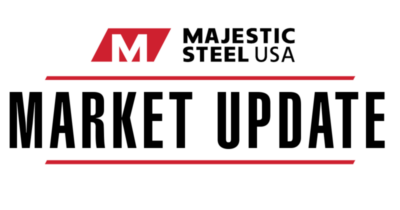Market Update | December 14, 2022
SECOND DOMESTIC SPOT PRICE INCREASE IN THE LAST 3 WEEKS
After Domestic Mills raised spot pricing by roughly $60/t in mid-November, Cleveland Cliffs became the first to announce a second spot price increase for $50/t. Also setting minimum HRC pricing at $750. NLMK has followed Cliff’s lead and increased prices by $50/t as well. Increasing raw material costs and improved distribution market activity were reasons for the most recent increase.
Input Costs
As the recent up and down movement for zinc continues, pricing rebounded for the second consecutive week.
-
-
Zinc pricing came in at $1.51/lb this week, up from $1.45/lb previously and back over $1.50/lb for the first time since early September.
-
Spot iron ore pricing inched higher this week, climbing to $110.50/mt.
-
-
This is up 0.5% from the end of last week and is up 15.7% on a m/m basis.
-
December prime scrap pricing increased $30/gt in most regions, ending a string of seven consecutive declines.
-
-
Early indications are for further strengthening around scrap pricing in January.
-
Supply
U.S. raw steel production increased slightly again last week, now up for the second consecutive week.
-
- U.S. steelmakers produced 1.635 million tons at an 73.3% utilization rate.
- Production last week was down 7.5% compared to the same week last year and YTD production is now down 5.5% from the same time last year.
Based on preliminary import license data, the daily average for December (12 days) shows flat rolled steel imports were down 15.8% compared to November.
-
- While still early in the month, coated imports are tracking flat month-over-month.
Hot-dipped galvanized import licenses showed a 9.3% declined compared to October.
-
- Total carbon flat rolled inventory came in at 4.157 million tons, down 3.8% from 4.320 million tons in October.
- Carbon flat rolled inventory saw its first year-over-year decline since August 2021 however, sliding 5.1% from 4.379 million tons in November 2021; the year-over-year decline ended a string of fourteen consecutive months with an increase.
- Coated flat rolled inventory came in at 1.124 million tons, down from 1.206 million tons in October but still up 3.8% from 1.084 million tons in November 2021.
DEMAND
Overall carbon flat rolled shipments, from U.S. service centers, slipped lower on a month-over-month basis but were up 3.1% from year ago levels.
-
-
Total carbon flat rolled shipments declined to 2.006 million tons, down from 2.126 million tons in October but were up 3.1% from 1.946 million tons in November 2021.
-
Coated flat rolled shipments totaled 533.2 thousand tons (26.7 thousand tons/day) in November; this is down from 571.6 thousand tons (27.2 thousand tons/day) in October and is down from 614.3 thousand tons (30.7 thousand tons/day) in November 2021.
- November was the weakest shipment month for coated flat rolled material since May 2020.
-
economic
Prices paid by consumers increased at a slower rate in November and has now seen five consecutive months of slowing growth since peaking in June.
-
- The Consumer Price Index increased 7.11% compared to November last year and was down 0.10% from October.
- Excluding food and energy, prices increased 0.10% from October and were up 5.96% from November 2021.
- The shelter index (+7.1%) accounted for nearly half of the total year-over-year increase.
- Household furnishings (+7.6%), medical care (+4.2%) and new vehicles (+7.2%) all saw notable year-over-year increases in November.
The shipment component of the Freight Index slipped in November, sliding 1.9% from October and 0.4% compared to November 2021.
- Temporary factors like end of the year inventory repositioning and pre-interest rate hike demand helped push the shipment component higher of late but that started to ease in November.
- While the overall environment is stable, headwinds such as weaker imports and slowing consumer demand could pull the index lower.
- The expenditure component, which measures the total spend on freight, increased 1.8% from October and was up 4.7% compared to a year ago.
- The slowing of shipments, combined with the increases to spend lead to an increase in overall freight rates.
- Inferred freight rates (spend/shipments) increased 3.7% in November.
This material, information and analyses (the “Content”) may include certain statements, estimates and projections prepared with respect to, among other things, historical data and anticipated performance. Content may reflect various assumptions by Majestic Steel USA, Inc. concerning anticipated results that are inherently subject to significant economic, competitive and other uncertainties and contingencies and have been included for illustrative purposes. Content is provided AS-IS.

